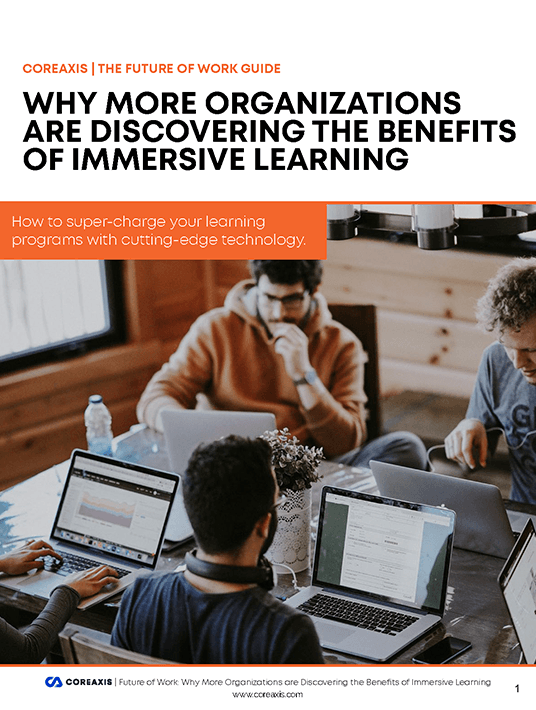Which Is Best For Your L&D Program: Virtual Reality Simulations Or Role-Playing?
While role playing is an effective tool for allowing learners to practice in a real-world situation, they can often become tedious and difficult to manage. Frankly, while some people love role playing, others hate it (which is understandable). This mode of learning doesn’t adapt to the unique needs of the learners, leaving some feeling underwhelmed by the experience. Lack of flexibility is only one challenge for role playing. To make it work, L&D professionals need to overcome a number of things along the way. Here are some of the top challenges involved with live role playing that virtual reality simulations can help you overcome.

3 Reasons Why Virtual Reality Simulations Surpass Role-Playing
1. Limitation Of Time And Space
First of all, you need the time and the space to support in-person role playing. This means that learners and facilitators are forced into a rigid time limit and are confined to a particular location and environment. Learners can’t be placed in a unique physical environment to better simulate the interaction. For example, a hotel desk clerk may be required to help point a guest toward the gym or a business center.
In a simulated VR experience, the learner can orient him or herself to the environment and look in various directions to help deliver accurate information to a guest. This isn’t possible in a live role play since the activity takes place far from job location. In-person role plays are a one-and-done learning event. The learner doesn’t have the opportunity to revisit the role play, practice it, fail, retry, and reflect upon their experiences. Nor do they have immediate feedback on what they’re experiencing.
When learning in a virtual environment, learners can be placed within ultra-realistic simulations that better emulate their job experience. Since experiences are flexible, learners can start, stop, retry, and reflect on a timeline that suits them, which gives them a greater sense of autonomy over their learning and helps to personalize their learning path.
2. Interactions Can Be Awkward
Not every person is a great actor, and not everyone loves to perform in front of others. In fact, for some, it’s one of their greatest fears. It makes it extremely difficult to simulate an interaction when learners are reticent to embrace their roles. For example, if you’re trying to train a medical professional how to deal with an aggressive patient or hospital guest, it’s going to be difficult for both the facilitator and learner to embrace their antagonistic roles. They may in fact be old friends!
When a learner puts a VR headset on, they are immersed, transported, and placed into a virtual environment where authentic interactions can produce authentic emotional responses. While it can be scary at times, the learner understands that she or he is in a safe space. Avatars and personas created within a VR environment can be developed to demonstrate and simulate a number of different types of interactions. Faced with realistic situations, learners feel an authentic, visceral reaction to unique circumstances. Facilitators can be present within the simulation to assist learners and keep them grounded in reality (the world outside of the headset).
3. Assessment Opportunities Are Limited
Apart from the notes taken by a facilitator, it’s difficult to tie learning objectives to learning outcomes. This makes it difficult for L&D professionals to demonstrate how learning programs are providing value to the business. Simply checking a box to prove a person has taken training doesn’t verify how well they’ve absorbed the training, nor does it indicate how behavior has been affected. Because the training environment is abandoned at the end of the session, it’s difficult to follow up with learners and understand what they’ve retained.
The more intervention and support facilitators can provide, the more likely a learner will absorb the training designed for them. Data derived from VR training systems provides an enormous amount of actionable insight regarding the success of training. Over time, L&D professionals can check in with learners to see what they’ve retained or to provide them additional resources as a refresher.
The Business Case For Immersive Learning
Companies that embrace a culture of learning are becoming more attractive to new hires. Providing modern and cutting-edge training, learning and development drives hiring and retention. Employees feel confident in a company that supports long-term career development and their personal interests. Leaning towards remote learning and work is becoming a competitive advantage for successful companies.
In addition, VR and AR are easily scalable Learning programs using emerging technologies can be scaled to a global level with reduced expenses associated with development and deployment. There are considerable costs associated with in-person training. For example, sending a single facilitator to deliver training requires a hotel, flight, per diem, lost work time, rental of equipment and space, etc. Furthermore, making adjustments and enhancements to learning programs year upon year is a simple matter with content being updated in real time, across the globe.
After the initial investment in hardware and infrastructure, learning programs can be delivered at virtually no expense. In most cases, companies can leverage their existing learning management system (LMS) and mobile apps to deliver training.
Download the eBook The Future Of Work Guide: Why More Organizations Are Discovering The Benefits Of Immersive Learning for tips to launch an immersive learning program for your telecommuting teams.








